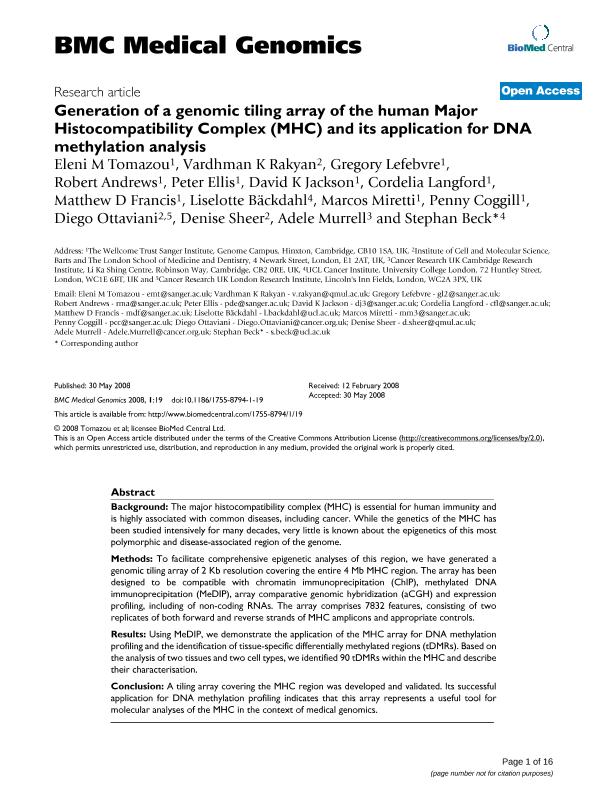Mostrar el registro sencillo del ítem
dc.contributor.author
Tomazou, Eleni M
dc.contributor.author
Rakyan, Vardhman K
dc.contributor.author
Lefebvre, Gregory
dc.contributor.author
Andrews, Robert
dc.contributor.author
Ellis, Peter
dc.contributor.author
Jackson, David K
dc.contributor.author
Langford, Cordelia
dc.contributor.author
Francis, Matthew D
dc.contributor.author
Bäckdahl, Liselotte
dc.contributor.author
Miretti, Marcos Mateo

dc.contributor.author
Coggill, Penny
dc.contributor.author
Ottaviani, Diego
dc.contributor.author
Sheer, Denise
dc.contributor.author
Murrell, Adele
dc.contributor.author
Beck, Stephan G.

dc.date.available
2020-09-14T15:31:57Z
dc.date.issued
2008-05
dc.identifier.citation
Tomazou, Eleni M; Rakyan, Vardhman K; Lefebvre, Gregory; Andrews, Robert; Ellis, Peter; et al.; Generation of a genomic tiling array of the human Major Histocompatibility Complex (MHC) and its application for DNA methylation analysis; BioMed Central; Bmc Medical Genomics; 1; 19; 5-2008; 1-16
dc.identifier.uri
http://hdl.handle.net/11336/113919
dc.description.abstract
Background: The major histocompatibility complex (MHC) is essential for human immunity and is highly associated with common diseases, including cancer. While the genetics of the MHC has been studied intensively for many decades, very little is known about the epigenetics of this most polymorphic and disease-associated region of the genome. Methods: To facilitate comprehensive epigenetic analyses of this region, we have generated a genomic tiling array of 2 Kb resolution covering the entire 4 Mb MHC region. The array has been designed to be compatible with chromatin immunoprecipitation (ChIP), methylated DNA immunoprecipitation (MeDIP), array comparative genomic hybridization (aCGH) and expression profiling, including of non-coding RNAs. The array comprises 7832 features, consisting of two replicates of both forward and reverse strands of MHC amplicons and appropriate controls. Results: Using MeDIP, we demonstrate the application of the MHC array for DNA methylation profiling and the identification of tissue-specific differentially methylated regions (tDMRs). Based on the analysis of two tissues and two cell types, we identified 90 tDMRs within the MHC and describe their characterisation. Conclusion: A tiling array covering the MHC region was developed and validated. Its successful application for DNA methylation profiling indicates that this array represents a useful tool for molecular analyses of the MHC in the context of medical genomics.
dc.format
application/pdf
dc.language.iso
eng
dc.publisher
BioMed Central

dc.rights
info:eu-repo/semantics/openAccess
dc.rights.uri
https://creativecommons.org/licenses/by-nc-sa/2.5/ar/
dc.subject
HUMAN MAJOR HISTOCOMPATIBILITY
dc.subject
HLA
dc.subject
GENOMIC ARRAY
dc.subject.classification
Otras Ciencias Biológicas

dc.subject.classification
Ciencias Biológicas

dc.subject.classification
CIENCIAS NATURALES Y EXACTAS

dc.title
Generation of a genomic tiling array of the human Major Histocompatibility Complex (MHC) and its application for DNA methylation analysis
dc.type
info:eu-repo/semantics/article
dc.type
info:ar-repo/semantics/artículo
dc.type
info:eu-repo/semantics/publishedVersion
dc.date.updated
2018-09-18T14:05:04Z
dc.identifier.eissn
1755-8794
dc.journal.volume
1
dc.journal.number
19
dc.journal.pagination
1-16
dc.journal.pais
Reino Unido

dc.journal.ciudad
Londres
dc.description.fil
Fil: Tomazou, Eleni M. Wellcome Trust Sanger Institute; Reino Unido
dc.description.fil
Fil: Rakyan, Vardhman K. Institute of Cell and Molecular Science; Reino Unido
dc.description.fil
Fil: Lefebvre, Gregory. Wellcome Trust Sanger Institute; Reino Unido
dc.description.fil
Fil: Andrews, Robert. Wellcome Trust Sanger Institute; Reino Unido
dc.description.fil
Fil: Ellis, Peter. Wellcome Trust Sanger Institute; Reino Unido
dc.description.fil
Fil: Jackson, David K. Wellcome Trust Sanger Institute; Reino Unido
dc.description.fil
Fil: Langford, Cordelia. Wellcome Trust Sanger Institute; Reino Unido
dc.description.fil
Fil: Francis, Matthew D. Wellcome Trust Sanger Institute; Reino Unido
dc.description.fil
Fil: Bäckdahl, Liselotte. University College London; Reino Unido
dc.description.fil
Fil: Miretti, Marcos Mateo. Wellcome Trust Sanger Institute; Reino Unido. Consejo Nacional de Investigaciones Científicas y Técnicas. Centro Científico Tecnológico Conicet - Nordeste. Instituto de Biología Subtropical. Instituto de Biología Subtropical - Nodo Posadas | Universidad Nacional de Misiones. Instituto de Biología Subtropical. Instituto de Biología Subtropical - Nodo Posadas; Argentina
dc.description.fil
Fil: Coggill, Penny. Wellcome Trust Sanger Institute; Reino Unido
dc.description.fil
Fil: Ottaviani, Diego. London Research Institute; Reino Unido. London School of Medicine and Dentistry; Reino Unido
dc.description.fil
Fil: Sheer, Denise. London School of Medicine and Dentistry; Reino Unido
dc.description.fil
Fil: Murrell, Adele. Cambridge Research Institute; Reino Unido
dc.description.fil
Fil: Beck, Stephan G.. University College London; Reino Unido
dc.journal.title
Bmc Medical Genomics

dc.relation.alternativeid
info:eu-repo/semantics/altIdentifier/doi/http://dx.doi.org/10.1186/1755-8794-1-19
dc.relation.alternativeid
info:eu-repo/semantics/altIdentifier/url/https://bmcmedgenomics.biomedcentral.com/articles/10.1186/1755-8794-1-19
Archivos asociados
